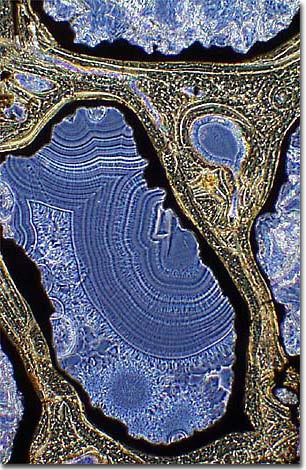Phase Contrast Image Gallery
Hadrosaurus: Duck-Billed Dinosaur
Thin sections of fossilized dinosaur bones often reveal clues about the anatomy and physiology of these long-extinct, but fascinating creatures. The photomicrograph below illustrates a phase contrast image of a 30-micron thick thin section of a hadrosaurus bone.

Analysis of this photomicrograph reveals an agate-like deposition of minerals within the canals of the bone structure. These deposits are often birefringent and can display a kaleidoscopic array of color when viewed under polarized illumination with a microscope.
The hadrosaurs, often referred to as the "duckbilled dinosaurs", were a group of plant-eating dinosaurs that evolved during the Jurassic era, 135-205 million years ago. By the end of the Cretaceous era, 65 million years ago, they were widely distributed in Europe, Asia, and North America.
Some species of hadrosaurs had large crests, the function of which has baffled scientists for many years. Curiously, the nasal passages loop from the nose through the crest, forming large sinuses (spaces in the skull) before passing into the airway. Today, the most accepted theory of the crest's function is that it served as a resonating chamber, allowing these dinosaurs to call to each other with warnings of predators or to attract potential mates. The crest may also have functioned as a visual display device to attract mates.
Hadrosaurs were fairly large, ranging in length from 27 to 33 feet (9-11 meters). Fossil evidence shows that they had webbed hands, suggesting that they spent at least part of their lives in bodies of water. However, their stiff tails, supported by ossified tendons, as well as their sturdy bones and rapidly-replaced teeth, indicate that hadrosaurs spent most of their time on land feeding on tough terrestrial plants. Discoveries of spectacularly preserved hadrosaur nests with eggs and young shows that hadrosaurs migrated to higher ground to reproduce.
BACK TO THE PHASE CONTRAST GALLERY
